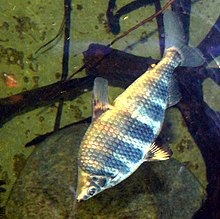Abramites hypselonotus
| Abramites hypselonotus | |
|---|---|

| |
| Scientific classification | |
| Domain: | Eukaryota |
| Kingdom: | Animalia |
| Phylum: | Chordata |
| Class: | Actinopterygii |
| Order: | Characiformes |
| Family: | Anostomidae |
| Genus: | Abramites |
| Species: | A. hypselonotus
|
| Binomial name | |
| Abramites hypselonotus (Günther, 1868)
| |
Abramites hypselonotus – known as the marbled headstander or the high-backed headstander – is a member of the family Anostomidae[2] of the order Characiformes.[3] Under normal fish classifying rules, the marbled headstander would be classified as a surface dweller. In reality marbled headstanders – like all headstanders – inhabit the middle and lower portions of the aquarium.[4] In the wild, head standers are often found face down, tail up in narrow vertical rocky fissures.[5]
Description
[edit]
Marble headstanders are generally identified by their high-backs,[6] pointed snout, diamond-shaped body, brown markings on pelvic fin, wavy dark brown bands, and a dark line at the base of the caudal peduncle. The marble headstanders full adult size is roughly 5 in (13 cm),[4] on both sides. They are among the rarely introduced representatives of the Anostomidae and the males are more contrasted than the females.[7]
Distribution and habitat
[edit]The marbled headstander generally inhabits streams and rivers of the Orinoco and Amazon river systems.[4] Headstanders most commonly inhabit very fast flowing waters in rocky stretches of river.[5]
Diet and feeding behaviour
[edit]The marble headstander is a predominantly herbivorous fish and as such should be given a high vegetation diet. In addition to processed food, it will readily accept (and probably enjoy) lettuce leaves, and peas. They will also accept mosquito larvae and bloodworms.[5]
Aquarium care
[edit]In the aquarium, the marble headstander is known as a peaceful inhabitant. They are completely docile as juveniles both towards other fish and members of their own species. As they get older, they should be kept either as a single headstander or a group of seven or more in a tank as they tend to fight amongst themselves in smaller groups. They are still generally peaceful towards other fish.
Due to the high demand of plant food, robust plants have a small chance of survival due to the sprouting of shoots. A socialization should be done with other great tetras that have similar claims. Keep marble headstanders in a rocky, heavily planted aquarium for them to explore,[5] too small aquariums lead to increased quarrels between conspecifics, which can be avoided by sufficiently offered hiding places with roots and stone structures, consisting of cracks and crevices.[8] If there is not enough vegetation in its diet, it will devour aquarium plants. On the other hand, you can use this to your advantage if you want to set up a "self-sustaining aquarium", please keep in mind that this is not an easy task, do not just throw a bunch of plants in and think it will be fine.[5]
Temperature, pH, and salinity
[edit]These fish can tolerate a pH from 6–7.5, but prefer slightly acidic water. They like soft water ranging from 2–15 dH, and require a temperature of 73–82 °F (23–28 °C).[8]
References
[edit]- ^ Frederico, R.G. (2022). "Abramites hypselonotus". IUCN Red List of Threatened Species. 2022: e.T49830259A158549868. doi:10.2305/IUCN.UK.2022-2.RLTS.T49830259A158549868.en. Retrieved 29 December 2023.
- ^ "Abramites hypselonotus – Marbled Headstander (Abramites ternetzi, Abramites microcephalus) — Seriously Fish". Retrieved 2021-09-06.
- ^ Froese, Rainer; Pauly, Daniel (eds.). "Abramites hypselonotus". FishBase. September 2021 version.
- ^ a b c Mills, Dick (1993). Aquarium fish. Photos by Jerry Young (1st American ed.). New York: Dorling Kindersley. p. 84. ISBN 1564582930. OCLC 27679009.
- ^ a b c d e Bailey, Mary (2 January 2015). The ultimate encyclopedia of aquarium fish & fish care: a definitive guide to identifying and keeping freshwater and marine fishes. Wigston, Leicestershire. p. 187. ISBN 9781780193410. OCLC 890938393.
{{cite book}}: CS1 maint: location missing publisher (link) - ^ Dawes, John; Beer, Amy Jane; Alderton, David (2005). Animal Fact Files: Fish (1st ed.). London: Greenwich Editions. ISBN 0862887747. OCLC 71766903.
- ^ Meyer, Rolf (1989). Aquarienfische (1st ed.). Leipzig: Bibliographisches Institut. p. 9. ISBN 3323002792. OCLC 22763526.
- ^ a b Riehl, Rüdiger (1996). Aquarium Atlas, Band 3 (in German). Vol. 3rd (1st ed.). Melle, Germany: Steven Simpson Books. p. 100. ISBN 3882440538. OCLC 35656300.

